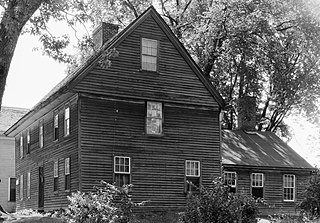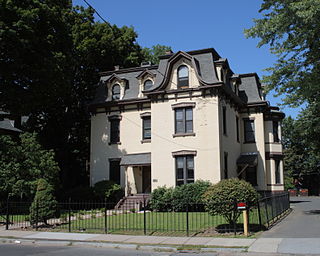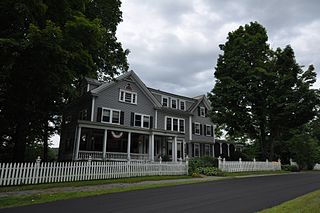
The Stowe Center for Literary Activism is a history museum and National Historic Landmark at 73 Forest Street in Hartford, Connecticut that was once the home of Harriet Beecher Stowe, author of the 1852 novel Uncle Tom's Cabin. Stowe lived in this house for the last 23 years of her life. It was her family's second home in Hartford. The 5,000 sq ft cottage-style house is located adjacent to the Mark Twain House and is open to the public. It was listed on the National Register of Historic Places in 1970, and declared a National Historic Landmark in 2013.

The Buttolph–Williams House is a historic house museum at 249 Broad Street in Wethersfield, Connecticut. Built in 1711, it is one of the oldest surviving houses in the town. It is owned by Connecticut Landmarks, a historic preservation organization, and is open for regular tours between May and October. it was designated a National Historic Landmark in 1968 for its significance as an extremely well-preserved example of early colonial architecture.

136–138 Collins Street is an architecturally distinguished Second Empire house in Hartford. Built about 1870, it is a rare and well-preserved example of this style in the city. It was listed on the National Register of Historic Places on April 29, 1982.

The Perkins–Clark House is a historic house at 49 Woodland Street in Hartford, Connecticut. Built in 1861, it is a prominent example of high-style Gothic Revival residential architecture, and is notable for the association of its first owner, Charles Perkins, with author Samuel Clemens. The house was listed on the National Register of Historic Places on December 14, 1978, and is a contributing property to the Nook Farm and Woodland Street District.

The Sarah Whitman Hooker House is a historic house at 1237 New Britain Avenue in West Hartford, Connecticut. Built about 1720, it is believed to be the oldest standing house in the town. It was listed on the National Register of Historic Places on November 1, 1979.

The Whitman House is a historic house at 208 North Main Street in West Hartford, Connecticut. Built about 1764, it is one of the town's few surviving 18th-century buildings. It was listed on the National Register of Historic Places on September 10, 1986.

The Elizabeth R. Hooker House is a historic house at 123 Edgehill Road in New Haven, Connecticut. It is a 2+1⁄2-story brick English-style Arts and Crafts suburban villa designed by Delano and Aldrich and built in 1914 for Elizabeth R. Hooker (1874-1965). Hooker was a 20th-century progressive activist, scholar, and writer in areas such as women's rights, public health care, and historic preservation. The house was added to the National Register of Historic Places in 2010.

The house at 36 Forest Street, sometimes called the Burton House in Hartford, Connecticut, United States, is a wooden Shingle Style structure built in the late 19th century and largely intact today. It was listed on the National Register of Historic Places in 1983.

The Theron Boyd Homestead is a historic farm property on Hillside Road in Hartford, Vermont. The centerpieces of the 30-acre (12 ha) property are a house and barn, each built in 1786. The house, little altered since its construction, is one of the finest early Federal period houses in the state. The property is owned by the state, which has formulated plans to open it has a historic site. It was listed on the National Register of Historic Places in 1993.

The Dewey House is a historic house at 173 Deweys Mills Road in Hartford, Vermont. Built in 1876 by a local mill owner, and remodeled in 1903, it is a high quality local example of residential Colonial Revival architecture. It was listed on the National Register of Historic Places in 1999.

Nook Farm is a historical neighborhood in the Asylum Hill section on the western edge of Hartford, Connecticut, USA.

The Amos Bull House is a historic house at 59 South Prospect Street in Hartford, Connecticut. Built about 1788, it is one of only a few surviving 18th-century buildings in the city. It was listed on the National Register of Historic Places in 1968. It presently houses the main offices of Connecticut Landmarks, a historic preservation organization.
The Abraham Coult House is a historic house at 1695 Hebron Avenue in Glastonbury, Connecticut. Built in about 1706 and enlarged several times, it is a well-preserved colonial residence, exhibiting changing construction methods through its alterations. Moved in the 1970s to avoid demolition and restored, it was listed on the National Register of Historic Places in 2000.

The Day-Taylor House is a historic house at 81 Wethersfield Avenue in Hartford, Connecticut. Built in 1857, it is one of state's best examples of Italianate villa architecture executed in brick. It was listed on the National Register of Historic Places in 1975. It presently houses offices.

The Gridley-Parson-Staples House is a historic house museum at 1554 Farmington Avenue in Farmington, Connecticut. Probably built about 1760, it is the oldest surviving house in northwestern Farmington, and a fine example of 18th century Georgian architecture. It is now home to the Farmington Historical Society, and was listed on the National Register of Historic Places in 1981.

The Lewis-Zukowski House is a historic house at 1095 South Grand Street in Suffield, Connecticut. Built in 1781, it is rare in the town as an 18th-century residence built out of brick, accompanied by a mid-19th century barn. It was listed on the National Register of Historic Places in 1990.

The John Robbins House is a historic house at 262 Old Main Street in Rocky Hill, Connecticut. Normally attributed a construction date of 1767, it is considered one of the finest examples of brick Georgian architecture in the state. It was listed on the National Register of Historic Places in 1988.

The Terry-Hayden House is a historic house on Middle Street in Bristol, Connecticut. Built in 1835 and enlarged in 1884, it is a well-preserved example of a Greek Revival house with a four-column temple portico. Now part of a professional office complex called Terry Commons, it was listed on the National Register of Historic Places in 1982.

The Townsend G. Treadway House is a historic house at 100 Oakland Street in Bristol, Connecticut. Built in 1915, it is one of the city's largest and finest examples of Colonial Revival architecture, designed by a major New York architectural firm. It was listed on the National Register of Historic Places in 1991.

The State Arsenal and Armory, formally the Governor William A. O'Neill State Armory and informally the Connecticut State Armory, is a historic military facility at 360 Broad Street in Hartford, Connecticut. Built in 1906, it is a distinctive example of Classical Revival architecture, built using then-innovative construction techniques involving concrete and cast stone. It was listed on the National Register of Historic Places in 1996. It serves as the headquarters of the Connecticut State Militia.





















